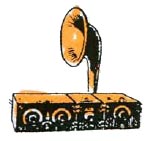|

This story was published in Radio Recall, the journal of the Metropolitan Washington Old-Time Radio Club, published six times per year.
Click here to return to the index of selected articles.
|
|
 LOOKING FOR RADIO IN EUROPE LOOKING FOR RADIO IN EUROPE
by Mark Anderson © 2010
(From Radio Recall, December 2010)
Last summer I went to Europe and found the history of radio. It was wrapped inside my excursion to three beautiful cities on the Danube – Budapest, Bratislava, and Vienna. Some might say that I could have found that history at the renown Museum of Broadcasting in Bowie MD. I, however, have always enjoyed taking the great circle route, wherever I’m headed.
For twelve days I absorbed the culture and endured the heat wave that had the region in its grip. I learned the history of nations, both the vitality of present day life and their disturbing and beleaguered past. I traveled by water taxi between the cities. I got around on foot and by rail; and figured how to read the Celsius scale.
In Vienna, the Museum of Technology is a wonderful, ornate building. It looks like a palace; it’s down the street from a palace; but since 1909 it has had its own pride of place and mission. A huge skylight arches above four levels of concourses, corridors, and the central courtyard.
I was aiming for Level Four – Communication and Transportation - where I would be at eye-level with a small plane suspended there. Took a while, but finally I was skirting the Kino exhibit and ambling past a horse drawn postal cart. The pneumatic tube exhibit gave way to a vintage mural size photograph of people sitting around a garden table. They were wearing headphones and listening to Radio Wien. The RUNDFUNK exhibit had begun!
I read about Lee DeForest and his 1910 broadcast of Caruso singing at the Met. I looked at early receivers – antennas and crystals; probes and tuning coils. There were crystals kept in a box the size of an aspirin tin. Receivers from pioneering companies were on display – Telefunken, Max Böhnel, and a Newark NJ company, Martian Manufacturing, whose 1924 receiver (a tripod supporting a plate and a paneled drum) indeed had the look of something that had just landed.
By the early 1930s amplification was in, and people could listen without headphones. Stylish wood cabinet radios had dials and the cities-in-range printed on the glass.
The grim reality of that era was thrust upon me when I found myself standing in front of a display case of a dozen or fifteen examples of the square black “Volksemfänger,” the people’s receiver. The dark photo-mural showed a crowded urban street. Radio was now a tool of the Third Reich. The cultural aspect of technology had turned malevolent. The exhibit narrative detailed the indignities heaped upon the populace: controlled broadcasts, inflammatory speeches, and the 1934 law prohibiting Jews from owning a radio.

The monstrous implications of the exhibit were still with me as I shuffled toward the colorful display of 1970s style portables. Transistor heaven proved to be a nice way to ease out of the Rundfunk corridor.
The stark tone and detailed explanation of the “people’s radio” exhibit was found in other exhibits of the museum. Urban planning, for example, a great idea for Vienna in the 1920s, gave rise to ethnic discrimination in housing. And when the assessment of other needs of people in a civil society, (work, transport, leisure, for example), became sinister with the measurement of the human beings themselves, the guide book was no less clear about the horrible application of science gone wrong.
My wanderings from level to level brought me eye-to-eye with many more things. I spun the wooden wheel of probability, with its ball bearings and posts and chutes. I saw my first and only Theremin. I operated a bank of solar panels across a diorama landscape. Boats, bicycles, a bell-casting apparatus, it was all there. I was realizing how little I knew about technology and how much there is to learn about the nature of human beings.
|